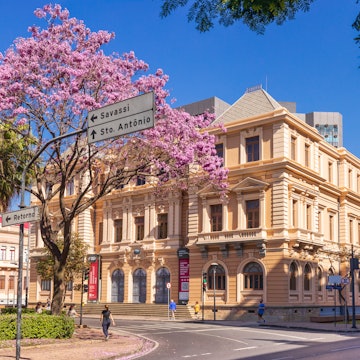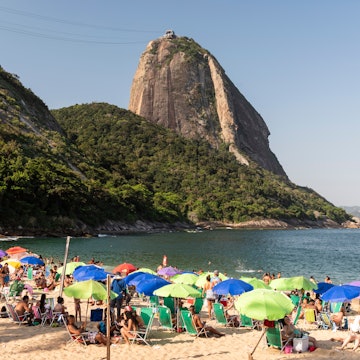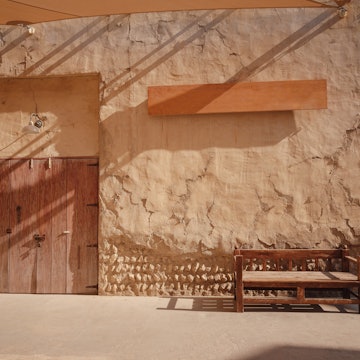

Free diving at 'Sancho' beach in the Arquipélago de Fernando de Noronha. Global_Pics / Getty Images
Home to Earth's biggest river, most immense jungle and 7400km of Atlantic-stroked beaches – Brazil is a sensationally sultry centre of exotic adventure.
The world’s fifth largest country tempts travellers with myriad adventures, from exploring epic kite-surfing conditions along the curvy Atlantic coastline to tackling trails, paddling tributaries and clambering up towering trees in the sweaty embrace of the Amazon – a wilderness so enormous it still contains lost cities and tribes that have no contact with the outside world. Seventy-six national parks provide great trekking and trail-running opportunities, while on- and off-road cyclists are well catered for, and rock climbers can explore cracking crags, including routes on the iconic Sugarloaf Mountain in Rio de Janeiro.
Diving
Arquipélago de Fernando de Noronha, a 21-island marine park, has fantastic diving. Visibility can exceed 40m, and wildlife includes whales, lemon and reef sharks, clownfish, parrotfish and more. Closer to the mainland, Banco de Panela near Salvador is notable for wreck diving and marine life. While Recife is the place to go for shipwrecks – a hundred vessels are strewn on the seabed.
Trekking
Walking in Brazil is all about variety. Parque Nacional da Chapada Diamantina in the east is a forested landscape of dramatic tabletop mountains, spectacular waterfalls (Fumaça and Buracao) and caves. Vale do Pati is a 68km hike through the remote and sparsely populated interior highlands of Bahia, with overnight stays hosted by locals. Minas Gerais’ Parque Nacional Serra do Cipó in the southeast offers mountains, waterfalls and wild flowers, and in the northeast you can trek across the lagoon- and dune-dotted lunar-like landscape of the Parque Nacional Lençóis Maranhenses. And, just an hour’s drive from the favelas of Rio de Janeiro, verdant Parque Nacional Serra dos Órgãos could be on another planet; multiple walks can be enjoyed here, including to the park’s highest peak, Pedra do Sino, 14km from the entrance.

Cycling
Starting at Flamengo and finishing with a 7km loop of Lagoa, the flat-and-easy Rio cyclepath can be ridden in a couple of hours and grants bikers an eyeful of everything the city is famed for: Sugarloaf Mountain, Urca, Praia Vermelha, Copacabana and Ipanema. For a bigger challenge, keen roadies can trace the 3000km coastline separating Porto Alegre in Rio Grande do Sul in the south and Salvador in Bahia in the north, a route that skirts Florianópolis’ amazing beaches.
Mountain biking
Rio’s Olympic mountain-bike course, Deodroro X-Park, opened to the public after the Games. The 5.4km-long track reflects Rio’s culture and geography, with sandal-shaped dirt pits and coconut trees, a short climb to ‘Flag Mountain’ and a technical boulder-strewn descent. More groomed singletrack can be found at Cemucam in Cotia (São Paulo), where the 34km loop hosts the Brazilian mountain bike championships and 24-hour races. Those looking for an off-road journey can explore the 80km east–west traverse of sensational Parque Nacional da Serra da Canastra in Minas Gerais, starting from the main entrance, São Roque de Minas, and finishing by the 186m-high waterfall Cachoeira Casca D’Anta.

Paddling
To experience the headspins (insanely verdant fecundity, pink dolphins, potential sightings of capuchin monkeys, tapirs, three-toed sloths and caiman) and horrors (piranhas, humidity and horrendous insects) of the Brazilian rainforest, you need to travel along the water that powers it all. Multiday jungle-piercing canoe trips can be taken along tributaries of the Amazon, such the Urubu, which can be accessed via Manaus.
Sea kayaking is possible all along the Atlantic coast – including around Rio, offering a unique perspective of iconic sights such as Sugarloaf Mountain and Christo Redentor (Christ the Redeemer) – but the Costa Verde in southeast Brazil, accessed via Paraty in the Bay of Ilha Grande, is particularly spectacular, with dramatic Jurassic Park-esque coastline vistas and even a tropical fjord: Saco do Mamanguá.
Just 74km from the megatropolis of São Paulo, the Juquitiba River washes the urban grime from wide-eyed paddle-grabbers during white-water rafting trips that are at their Grade III–V feistiest in November–March. Rafting can also be enjoyed on the Foz do Iguaçu, by the famous falls, and on Rio Novo in Minas Gerais, Tijucas River in Santa Catarina and Jacaru River in Pará.

Surfing
Southern Brazil has the best surf, with epic oceanic swells hitting the Atlantic coast during the peak April–October season. Santa Catarina is the go-to state, and 40-beach Florianópolis is Brazil’s surf capital. Hollow right- and left-handers are found at Santinho, Galheta and Praia, while Joaqunia and Meio da Joca both have powerful lefts and rights.
Itacaré, with its diverse coastline on the central coast of Bahia (Salvador) offers great surf. Boca da Barra has a right-hander stretching for up to 2km, while Corais and Itacarezinho form tubes, and Tirinica, short, fast-travelling hollow waves. Arquipélago de Fernando de Noronha, a volcanic archipelago 354km off Brazil’s northern coastline, has some of the best surf northeast of Recife.
São Paulo has good surfing conditions just a couple of hours away on the state’s northern coastline, where Maresias is well-known for its tubes. The area is also popular for stand-up paddleboarding, bodyboarding and longboarding.
Kitesurfing & windsurfing
Fortaleza, on the northeast coast, is Brazil’s kite capital, with the area from Cumbuco to Flexeiras offering perfect wind conditions of 20- to 26-knots. Favourable breezes blow June–January across beaches such as Jericoacoara. Nearby Tatajuba is a shallow-water spot that lays claim to some of Brazil’s best winds, sometimes reaching 45 knots. Barra de Lagoa, south of Rio near Florianópolis, offers great conditions for beginners, with its flat lagoon.

Climbing
Brazil offers great climbing, from world-class bouldering to 600m walls. São Paulo and Minas Gerais both have crags, but Rio is the urban climbing capital of the world. Its national park is home to an urban forest, with hidden crags and boulders, most of which are granite.
Minais Gerais in the southeast has mainly limestone and quartzite crags, and offers sport and bouldering. Ninhos (the namesake of the local town) is a classic route with overhangs, but to access the route you have to do an unprotected scramble.
For something different, score a toucan-eye’s view of the Amazon by going tree climbing. Organised trips leave from Manaus and take punters up to 90m on giant ceiba and angelim trees.
Trail running
Challenging routes can be explored all through Brazil’s diverse national parks, but the annual Jungle Marathon is the ultimate Brazilian – and Amazonian – trail-running challenge. The race attracts ultrarunners from around the world who want to test themselves against Earth’s biggest jungle, tackling swamps, river crossings, scorching heat and humidity, and the odd apex predator. Runners have to be self-sufficient (except for water), and choose between 127km and 254km distances. The night stages are particularly memorable as the jungle comes to cacophonous life and the Amazon glistens under bright moonlight. Armed guards patrol some sections of the race, protecting runners against panthers. Beware the anacondas as well.
Don’t leave without…
Taking a tandem hang-gliding flight from Pedra Bonita over Rio de Janeiro, landing on a beach below. Check that the operator is certified by the Brazilian Hang- Gliding Association.
You may also like:
Unmissable experiences in the Brazilian Amazon
The Amazon rainforest is under threat: here's how you can help
The best beach towns of southern Bahia













